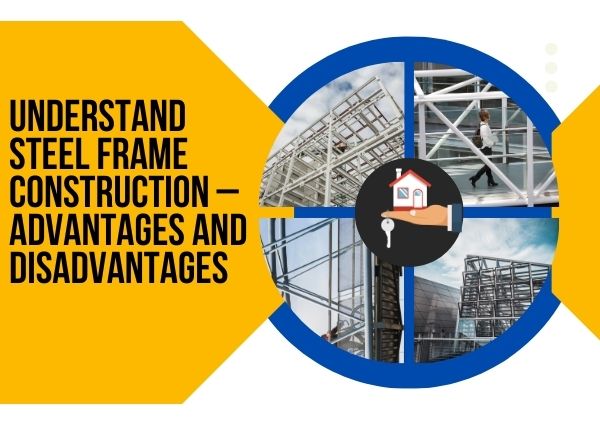Steel frame construction has become a popular method in modern architecture and construction, particularly for large-scale and commercial projects. It involves creating a framework of steel columns and beams to support floors, walls, and roofs, forming the skeleton of the building. Steel, known for its durability and strength, makes this construction method ideal for a variety of structures, including skyscrapers, warehouses, factories, and modern residential homes. However, like any building material, it has both benefits and drawbacks. At 3s Buildcon, we believe that understanding these advantages and disadvantages is essential to making an informed decision for your next project.
What is Steel Frame Construction?
A building method known as “steel frame construction” uses steel beams, trusses, and columns to provide the structural framework of the structure. The steel frame supports the floors, roofs, and walls, acting as the skeleton to which other materials are attached. Steel’s natural strength and flexibility have led to an increase in the employment of this method in the construction sector.
Steel framing mostly comes in two varieties:
- Conventional Steel Frame: Typically used in multi-story buildings like skyscrapers, involving beams and columns bolted or welded together.
- Light Gauge Steel Frame: Used primarily in smaller buildings, such as residential homes, where steel sheets are fabricated into a lightweight but strong frame.
Let’s now examine the benefits and drawbacks of steel frame construction in more detail.
Advantages of Steel Frame Construction
- Strength and Durability
The extraordinary strength of steel frame construction is one of its biggest benefits. Snow, storms, earthquakes, and high tension are just a few of the harsh weather conditions that steel can resist. Because of this, it is the preferred material for large, multi-story buildings and commercial constructions where strength is essential.
- Design Flexibility
Steel is both strong and flexible, allowing architects and engineers to explore innovative designs with minimal restrictions. It enables the construction of wide-span areas without internal columns, ideal for creating open, spacious environments like shopping malls or sports arenas. Additionally, steel frames can be easily modified, making future expansions and renovations simpler.
- Faster Construction Time
Steel components are often prefabricated off-site, meaning they are manufactured, measured, and partially assembled before arriving at the construction site.As a result, there is less work done on-site and the building process moves more quickly, which lowers labour costs and expedites project completion. Weather delays and other on-site issues are also reduced with faster construction.
4.Lightweight Material
Despite its strength, steel is relatively lightweight compared to other construction materials like concrete or brick. This facilitates on-site assembly and transportation. Less strain on the building’s foundation due to a lighter structure might also result in lower foundational work costs.
- Resistant to Pests and Fire
Steel, in contrast to wood, is unaffected by termites and rats, two pests that could otherwise harm a building’s construction. Steel frames also resist fire better than other materials since they are non-combustible. This is especially advantageous for structures requiring high safety standards, such as schools, hospitals, or public facilities.
- Eco-Friendly and Recyclable
Among the most environmentally friendly building materials is steel. It minimises waste and preserves natural resources because it can be recycled again without losing its structural integrity. Steel is a responsible material for projects that care about the environment because it is a material that is utilised in many modern construction projects and comes from recycled sources.
Disadvantages of Steel Frame Construction
- Cost of Materials
While steel offers many benefits, it is generally more expensive than other construction materials like wood or concrete. The price of raw steel can also fluctuate based on market conditions, which can impact the overall budget. This can make steel frame construction a less viable option for projects with tight financial constraints.
- Thermal Conductivity Issues
Steel is an excellent conductor of heat, which can cause thermal bridging in buildings. In simple terms, steel can transfer heat between the inside and outside of the building, reducing energy efficiency. To counteract this, additional insulation is often required, which increases both material and labour costs.
- Corrosion Vulnerability
Although steel is durable, it is still susceptible to corrosion over time, especially when exposed to moisture and humidity. Proper treatment and coatings are required to prevent rusting, which adds to maintenance costs. In coastal areas with high salt content in the air, special care must be taken to protect the steel framework.
- Skilled Labor Requirement
Steel frame construction requires workers with specialised skills to weld, bolt, and assemble the steel components. Hiring trained professionals can increase labour costs compared to other building methods that rely on more common construction skills.
- Noise During Construction
Because cutting, welding, and hammering are frequently involved, working with steel can be noisy. The noise pollution generated during the construction process can disturb nearby residents and businesses, which is a concern in urban areas. Effective noise control measures may be needed to minimise disruptions.
- Limitations in Residential Applications
While steel is ideal for large-scale projects, it may not always be the best fit for smaller residential buildings. Light gauge steel is used in homes, but it can be more expensive and less practical compared to wood framing. In addition, homeowners and contractors may not be as familiar with steel construction, making it less popular in residential projects.
Conclusion
Many advantages come with steel frame construction, including strength, durability, flexibility in design, and accelerated project completion times. It is especially well-suited for commercial and large-scale projects that demand structural integrity and open layouts. However, higher material costs, corrosion concerns, and the need for skilled labour present challenges that must be carefully managed.
At 3s Buildcon, we believe that steel frame construction is an excellent option for certain projects, particularly when efficiency, safety, and long-term performance are key priorities. Our team of experts ensures that the steel used in every project is properly treated and protected against environmental factors, minimising maintenance concerns.

